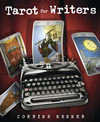A Tarot Brainstorming Technique

How many of us realize that our tarot decks are a fast, fun, and flexible tool that can help us make better decisions, be more creative, and achieve our goals? I bet most have. But I bet most of us haven't used some of the incredibly effective techniques of Mark McElroy, author of What's in the Cards for You? and Putting the Tarot to Work. Here is an excerpt with one of Mark's brainstorming techniques:
What to Do
From any Tarot deck, remove the Fool and the twenty-one trumps. Put these cards in order from zero (the Fool) to twenty-one (the World), and arrange them on a table so you can see each one.
Think of each of these twenty-two cards as twenty-two advisers who have been there and done that in the business world. No matter how complex your issue or difficult your situation, know that these twenty-two advisers have dealt with it dozens of times in the past. Whatever the issue, these advisers each confronted it, wrestled with it, and earned themselves a fat, luxurious bonus check for conquering it. Each has a unique perspective; each took a different approach. All, however, were incredibly successful.
Your goal is to tap into this collective reservoir of hard-won wisdom and practical experience. To do this, you must examine your situation or question from the perspective of each of these twenty-two successful mentors. With your decision or situation in mind, you start with the Fool and work your way down the line, asking, "In this situation, what would _________ do?" In other words, you start by asking, "What would the Fool do?" and conclude with "What would the World do?"
Ask this question with each trump in mind, and soon, you'll have twenty-two options for action. Some of these will be outrageous. Some will challenge your sense of ethics. Some will be brilliant…and some, positively obtuse. But of the twenty-two options, at least one is bound to surprise or inspire you.
Give yourself no more than thirty seconds per card, and go with the first course of action that pops into your head. Practice this technique, and in less than fifteen minutes, you can generate twenty-two different options for action in any situation! Best of all, once you become proficient with this brainstorming strategy, you won't need to have the actual cards in front of you. As a result, you can use this technique anytime, anywhere…and amaze people with your ability to come up with an apparently limitless stream of intriguing alternatives.
Practicing the Strategy
The Situation: A music retailer has increasing problems with shrinkage—losses due to shoplifting. Management encourages employees to watch the store more carefully, but the problem only worsens. With valuable tapes and CDs walking out of the store on a daily basis, the time comes to take corrective action. What to do?
Use the above strategy to brainstorm twenty-two courses of action. Be serious. Be silly. Be inventive. Be creative. Be open to any idea, no matter how strange or bizarre. Remember the goal: twenty-two ideas, no matter how outrageous or absurd, in fifteen minutes or less.
Before looking at the sample answers below, be sure to make out your own list!
Possible Answers
- What would the Fool do? Accuse everyone who left the store of shoplifting until he finally got one right.
- What would the Magician do? Learn how to be a great shoplifter in order to know what to watch for.
- What would the Priestess do? Set up observation cameras.
- What would the Empress do? Hold a workshop teaching employees how to catch shoplifters, and create a system for rewarding employees who finger thieves.
- What would the Emperor do? Dispatch uniformed security personnel to handle the situation.
- What would the Hierophant do? Post signs reminding people of the penalties of shoplifting.
- What would the Lovers do? Form a partnership with other local shop owners to share best practices for defeating shoplifting and share information on the identity of shoplifters.
- What would the Chariot do? Publicize cases in which shoplifters were successfully prosecuted to the fullest extent of the law as a way of defeating shoplifting before it begins.
- What would Strength do? Wrestle the shoplifters to the ground before they left the store!
- What would the Hermit do? Go away for a one-on-one seminar on stopping shoplifting.
- What would the Wheel do? Research to see if shoplifting rises and falls according to a predictable cycle, then staff extra people specifically to watch the floor at those times.
- What would Justice do? Hold court on the spot, sending the shoplifters directly to jail.
- What would the Hanged Man do? Ask others how they whipped the problem, then learn from their mistakes.
- What would Death do? Hand shoplifters merchandise and say, "Go ahead! Get it over with! No need to sneak around! Steal it!"
- What would Temperance do? Educate customers on how shoplifting harms them, too (creating higher prices, for example), then enlist their help in spotting and catching the thieves.
- What would the Devil do? Set a bounty for each shoplifter fingered (and then, maybe, wrongly accuse people in order to collect a big reward).
- What would the Tower do? Clear out the store and completely rearrange the floor plan with prevention of shoplifting in mind.
- What would the Star do? Set a goal for the reduction of shoplifting by a certain deadline.
- What would the Moon do? Watch shoplifters over cameras, then announce to the entire store over loudspeakers, "Hey, you in the blue shirt! I see you! Put it back!"
- What would the Sun do? Hold a big party for employees when the team reduced shoplifting to the point selected by the Star.
- What would Judgment do? Send shoplifters a wake-up call by posting photos of previous shoplifters in the store, complete with "This is what happened to them, and it can happen to you" stories attached.
- What would the World do? Make shoplifting obsolete by making everything in the store free for the taking.
Whew! That's a lot of ideas in a very little time!
When I started this exercise, I had no idea what my twenty-two answers would be. I generated the list in just over ten minutes, and reproduced it here with no editing at all.
s you can see, the degree of practicality varies from idea to idea. But, because I turned off my inner critic and kept working, I developed (without trying) a terrific anti-shoplifting strategy. The idea comes up again and again, in various forms, throughout my brainstorm: enlist the help of customers and employees…and reward those who catch thieves at work. Equally exciting ideas include: scheduling more employees at periods when shoplifting activity is known to be high, attending seminars to learn more about shoplifting techniques, keeping qualified law enforcement close at hand, and (my personal favorite) forming a coalition to share information with other vendors who are likely dealing with the same shoplifters. Combine these ideas with the Star's advice for setting a target date for reducing shoplifting by a given percentage…and the managers of this store have everything they need to launch and evaluate their anti-shoplifting plan.
And remember: your answers very likely differ from mine…and that's the way it should be. The goal isn't to mimic my ideas…it's to stifle your inner critic and come up with as many answers as possible in the shortest possible time.
The next time you need a solution, take a few minutes and give this technique a try.

About Barbara Moore
Related Products


is subject to certain Terms and Conditions